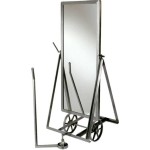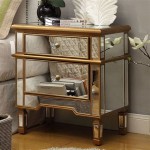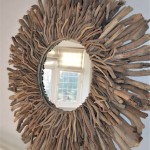DIY Frame for a Frameless Mirror
Adding a frame to a frameless mirror elevates its appearance, transforming a simple piece of glass into a stylish decorative element. This article explores the process of creating a DIY frame for a frameless mirror, offering various methods and material options to suit different aesthetics and skill levels.
Choosing the Right Materials
The choice of material significantly impacts the frame's final look and the project's complexity. Wood offers a classic, versatile option, ranging from rustic reclaimed wood to sleek, modern finishes. Moulding provides a more ornate and traditional aesthetic, available in various profiles and materials like wood, polyurethane, or plaster. For a minimalist, contemporary look, metal or acrylic can be used, offering a clean, streamlined finish. Repurposed materials, such as old picture frames, driftwood, or even mosaic tiles, can provide a unique and personalized touch.
Measuring and Cutting
Accurate measurement is crucial for a well-fitting frame. Measure the mirror's length and width precisely. When using wood or moulding, miter cuts are typically used at 45-degree angles to create seamless corners. A miter saw or miter box provides the best results for these cuts. For metal or acrylic, a straight cut is usually sufficient, utilizing a metal saw or plastic cutter, respectively. Always double-check measurements before cutting to avoid costly mistakes.
Assembling the Frame
The assembly process varies depending on the chosen material. Wood and moulding can be joined using wood glue and finishing nails, ensuring tight, secure corners. Clamps are helpful to hold the pieces together while the glue dries. Metal frames may require soldering or specialized connectors. Acrylic frames can be adhered with acrylic cement, taking care to avoid excess glue which can mar the finish. Consider pre-drilling pilot holes for screws or nails to prevent splitting, particularly when working with wood.
Attaching the Frame to the Mirror
Several methods exist for attaching the frame to the mirror. Construction adhesive provides a strong bond and is suitable for most materials. Mirror clips offer a more discreet option, particularly for thinner frames. For heavier frames, consider using L-brackets or Z-clips for added support. Ensure the chosen method can handle the weight of the frame and mirror combined. Always prioritize safety and follow manufacturer instructions for adhesives and hardware.
Finishing Touches
The finishing touches personalize the frame and enhance its durability. Wood frames can be stained, painted, or sealed with a clear coat to protect the wood and enhance its appearance. Metal frames might benefit from a protective sealant to prevent rust or corrosion. Consider adding decorative elements such as embellishments, paint details, or a contrasting inlay to create a unique and eye-catching piece. Allow ample drying time for any applied finishes before hanging the mirror.
Alternative Framing Techniques
Beyond traditional framing methods, consider alternative approaches for a unique aesthetic. A mosaic frame, created by adhering small tiles or pieces of glass to the mirror's edge, adds a vibrant, artistic flair. Rope or twine wrapped around the mirror creates a nautical or rustic look. For a minimalist approach, consider applying a decorative adhesive tape directly to the mirror's edge, creating a simple yet effective border.
Safety Precautions
Prioritize safety throughout the project. Wear appropriate safety glasses when cutting materials and using power tools. Gloves can protect hands from sharp edges and adhesives. Work in a well-ventilated area, particularly when using paints, stains, or adhesives with strong fumes. Dispose of materials responsibly, adhering to local regulations for waste management. Handle the mirror carefully to avoid breakage and potential injury.

Diy Picture Frame Trim On A Frameless Mirror Chris Loves Julia

How To Frame Out That Builder Basic Bathroom Mirror For 20 Or Less

How To Frame A Mirror

Diy Stick On Mirror Frame Sawdust Sisters

How To Build A Diy Frame Hang Over Bathroom Mirror Love Our Real Life

How To Build A Wood Frame Around Bathroom Mirror Young House Love

Diy Bathroom Mirror Frame Without Removing Clips Her Happy Home

How To Frame Out That Builder Basic Bathroom Mirror For 20 Or Less

Easy Diy Tutorial Adding Trim Around A Giant Mirror For Ers

Diy Bathroom Mirror Frame For Under 10 O Hayley Blog








